
If you want to prevent users of a PC from changing the desktop wallpaper, it’s not too hard to do. Here’s how to make it happen.
Whether you have PCs in a home or small business setting, there are times you might not want users of the PC to change the desktop background. Maybe you want a specific background in place, or maybe you just want to make sure nothing inappropriate gets added. Whatever your reason, Windows does provide ways of preventing changes to the desktop background. If you have a Home edition of Windows, you’ll need to make some edits to the Registry. If you have a Pro or Enterprise edition, you can make edits in the Registry or use the Local Group Policy Editor. By the way, if you’re interested, you might also want to prevent users from changing the screen saver for the same reasons.
The process for preventing changes to the desktop background requires two steps. First, you’ll disable the main Settings interface for changing the desktop background. This prevents users from using that interface to make the change. Then, you’ll also have to prevent them from changing the background by right-clicking an image and using the “Set as desktop background” command by forcing Windows to use a particular image as the background. We’ll show you how to take both these steps in the Registry and in Local Group Policy Editor.
Microsoft Account Users: Disable Syncing of Theme Settings
If you’re using Windows 8 or 10 and the user in question is tied to a Microsoft Account, you’ll need to take the additional step of disabling the syncing of theme settings before going on with the rest of this process. If you’re using local user accounts instead on your PC, you don’t have to worry about this step.
Sign in as the user for whom you plan to make the changes. Press Windows+I to open the Settings window and click “Accounts.”

In the Accounts window, on the left-hand side, click the “Sync your settings” tab and, on the right hand-side, turn off the “Theme” option.

You’ll need to do this for each user account you plan to disable desktop background changes for—as long as that user account is tied to a Microsoft account—no matter whether you use the Registry, one-click hack, or Local Group Policy methods we cover in this article.
Home Users: Prevent Changes to the Desktop Background by Editing the Registry Manually
If you have the Windows 7, 8, or 10 Home edition, you will have to edit the Windows Registry to make these changes. You can also do it this way if you have Windows Pro or Enterprise, but just feel more comfortable working in the Registry. (If you have Pro or Enterprise, though, we recommend using the easier Local Group Policy Editor, as described in the next section.)
Standard warning: Registry Editor is a powerful tool and misusing it can render your system unstable or even inoperable. This is a pretty simple hack and as long as you stick to the instructions, you shouldn’t have any problems. That said, if you’ve never worked with it before, consider reading about how to use the Registry Editor before you get started. And definitely back up the Registry (and your computer!) before making changes.
We’ve got instructions here for preventing screen saver changes by individual users on a PC or for all users of the PC. If you want to disable screen saver changes for an individual user, you’ll need to log on as the user you want to make changes for, and then edit the Registry while logged in to their account. If you have multiple individual users for whom you want to changes for, you’ll have to repeat the process for each user. If you want to make the changes for all user of the PC at once, including your own account, you can just stay signed on with your account.
After logging on with the appropriate account, open the Registry Editor by hitting Start and typing “regedit.” Press Enter to open Registry Editor and give it permission to make changes to your PC.

First, you’ll disable the desktop background settings in the Setting interface. In the Registry Editor, use the left sidebar to navigate to the following key if you want to disable screen saver settings for the currently logged in user:
HKEY_CURRENT_USER\Software\Microsoft\Windows\CurrentVersion\Policies

If you’d like to disable screen saver settings for all users of the PC at once, navigate to this key instead:
HKEY_LOCAL_MACHINE\Software\Microsoft\Windows\CurrentVersion\Policies
Note that everything about those two locations is the same, except for the hive. Items in
HKEY_CURRENT_USER apply only to the currently logged in user, while items in HKEY_LOCAL_MACHINE apply to all users. No matter which you choose, the rest of the steps are the same.
If you don’t see a key named “ActiveDesktop” under the
Policies key, you’ll need to create one. Right-click the Policies key and choose New > Key. Name the new key “ActiveDesktop.” If an ActiveDesktop key is already present, skip this step.
Next, you’ll create a new value inside the ActiveDesktop key. Right-click the ActiveDesktop key and choose New > DWORD (32-bit) Value. Name the new value “NoChangingWallPaper” and then double-click the new value to open its properties window.

In the properties window for the
NoChangingWallPaper value, change the value from 0 to 1 in the “Value data” box and then click “OK.”
This particular change will take place immediately, so if you try open up Settings > Personalization > Background, you’ll see that the whole page is grayed out and that the text “Some settings are managed by your organization” have been added to the top.

Next, you’ll need to force a particular wallpaper image so that other methods of changing the background—like right-clicking an image file—also don’t work. Back in the Registry editor, return to the same key you were working in before. As a reminder, for making changes for just the current users, that’s:
HKEY_CURRENT_USER\Software\Microsoft\Windows\CurrentVersion\Policies\
To force the change for all users of the PC at once, that’s this key:
HKEY_LOCAL_MACHINE\Software\Microsoft\Windows\CurrentVersion\Policies\
If you don’t see a key named “System” under the
Policies key, you’ll need to create one. Right-click the Policies key and choose New > Key. Name the new key “System.” If a System key is already present, skip this step.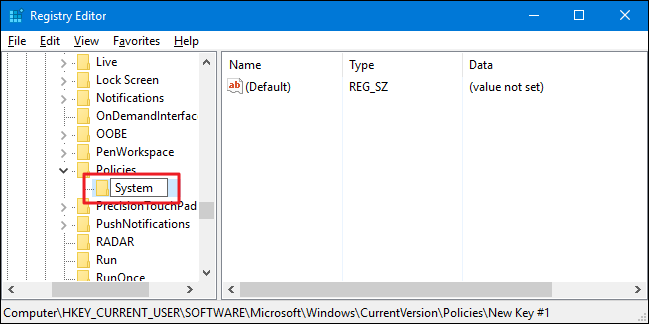
Next, you’ll create a new value inside the System key. Right-click the System key and choose New > String Value. Name the new value “Wallpaper.”

Double-click the new
Wallpaper value to open its properties window.
In the properties window for the
Wallpaper value, change the value to the location of the image file you want to use as the desktop background and then click “OK.” Note that you can only use JPG or BMP images. You can’t use any other image formats and you can’t choose a solid color background. As a workaround, you could create your own JPG or BMP image that is a solid color and use that.
Next, you’ll set the the wallpaper style by creating another value. Wallpaper style dictates whether the wallpaper is centered, tiled, and so on. To do this, right-click the System key and choose New > String Value. Name the new value “WallpaperStyle.”

Double-click the WallpaperStyle value to open it’s properties window. In the “Value data” box, type any of the following numbers to indicate how you want the image handled and then click “OK.” Just type the actual number, not the description in parentheses:
- 0 (Centered)
- 1 (Tiled)
- 2 (Stretched)
- 3 (Fit)
- 4 (Fill)
- 5 (Span)
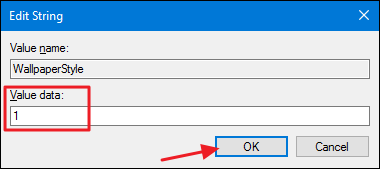
At this point, the desktop background should be fully protected from changes, so you can close Registry Editor. You’ll need to restart your PC (or sign out and back in) to have the changes take place. After that, if you were to try right-clicking a different image file and choosing “Set as desktop background” the desktop background should not change. You won’t get an error message. Instead, nothing at all should happen.
If you’re disabling background changes for multiple users, you can now sign in as the next user and repeat the process. If you ever want to reverse the changes, just sign back in as the user for whom you want to make changes, go back to the appropriate
System key in Registry Editor, and delete both the values you created: NoDispBackgroundPage and Wallpaper .Download Our One-Click Registry Hacks

If you don’t feel like diving into the Registry yourself, we’ve created some registry hacks you can use. All the hacks are included in the following ZIP file.
Desktop Background Hacks
After extracting the ZIP file, you’ll see two folders inside:
- The “Desktop Background Hacks for All Users” folder contains hacks that you would use to make these changes for all users on the PC.
- The “Desktop Background Hacks for Current User” folder contains hacks that you would use to make these changes for only the user that is currently signed in.
Inside each of these folders, you’ll find three hacks: one for disabling desktop background settings, one for forcing the wallpaper to a specific JPG or BMP image file, and one for reversing all changes and allowing changes to the desktop background again.
Before you can run the hacks, you will need to edit the hack for forcing the wallpaper to a specific image. Find either the “Force Wallpaper Image for All Users” or “Force Wallpaper Image for Current User” hack, depending on which way you’re doing things. Right-click the hack and choose “Edit” from the context menu to open the hack in Notepad.
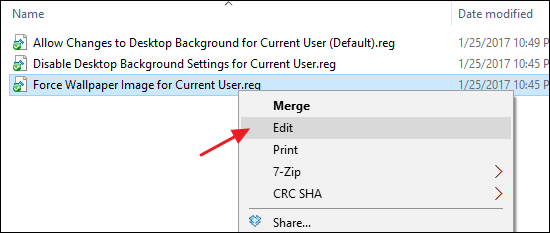
In the Notepad window, find the text that reads “PATH_TO_JPG_OR_BMP_FILE” and replace it with the full path to the JPG or BMP file you want to use for your desktop background, making sure the quotes stay in place. Change the value of WallpaperStyle to one of the numbers listed at the bottom of the text file, again leaving the quotes in place. You can then save the changes and exit Notepad.

Now, you can run the hacks by double-clicking the one you want to use and clicking through the prompts. Just remember that if you’re using the hacks for the current user only, you’ll need to sign in with the user account you want to make the changes for first.
These hacks are really just the
System and ActiveDesktop keys, stripped down to the NoChangingWallPaper and Wallpaper values we talked about in the previous section and then exported to a .REG file. The hacks for the current user only affect the System key found in the HKEY_CURRENT_USER hive, while the hacks that affect all users make changes to the System key in the HKEY_LOCAL_MACHINE hive. Running the hacks just modifies the value. And if you enjoy fiddling with the Registry, it’s worth taking the time to learn how to make your own Registry hacks.Pro and Enterprise Users: Prevent Changes to the Desktop Background with Local Group Policy Editor
If you’re using Windows Pro or Enterprise, the easiest way to lock out this change is by using the Local Group Policy Editor. It also gives you a bit more power over which users have this restriction. If you’re turning off the shortcuts for only some user accounts on a PC, you’ll need to do a little extra setup by first creating a policy object for those users. You can read all about that in our guide to applying local Group Policy tweaks to specific users.
You should also be aware that group policy is a pretty powerful tool, so it’s worth taking some time to learn what it can do. And if you’re on a company network, do everyone a favor and check with your admin first. If your work computer is part of a domain, it’s also likely that it’s part of a domain group policy that will supersede the local group policy, anyway.
Start by finding the MSC file you created for controlling policies for those particular users. Double-click to open it and allow it to make changes to your PC. If you just have one user account on your PC, you can open the regular Local Group Policy Editor instead by clicking Start, typing “gpedit.msc,” and then hitting Enter. That’s what we’re going to do in this example, but if you use an MSC file to apply the changes to certain users, the steps are the same.

First, you’ll disable the desktop background settings in the Setting interface. In the Group Policy window for those users, on the left-hand side, drill down to User Configuration > Administrative Templates > Control Panel > Personalization. On the right, double-click the “Prevent changing desktop background” setting to open its properties window.
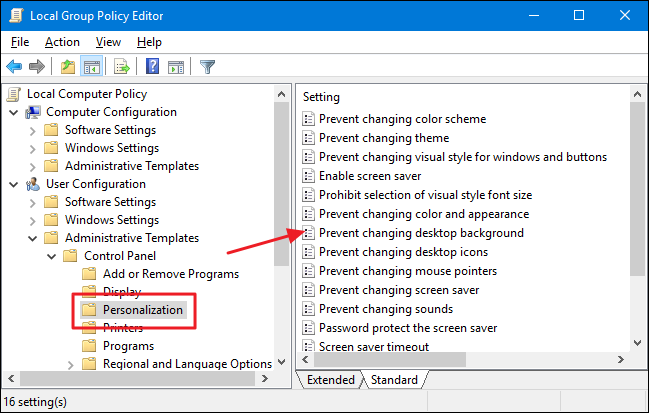
In the setting’s properties window, click the “Enabled” option and then click “OK.”

Next, you’ll need to force a particular wallpaper image so that other methods of changing the background—like right-clicking an image file—also don’t work. Back in the main Group Policy window, on the left-hand side, navigate to User Configuration > Administrative Templates > Desktop > Desktop. On the right, double-click the “Desktop Wallpaper” setting to open its properties window.
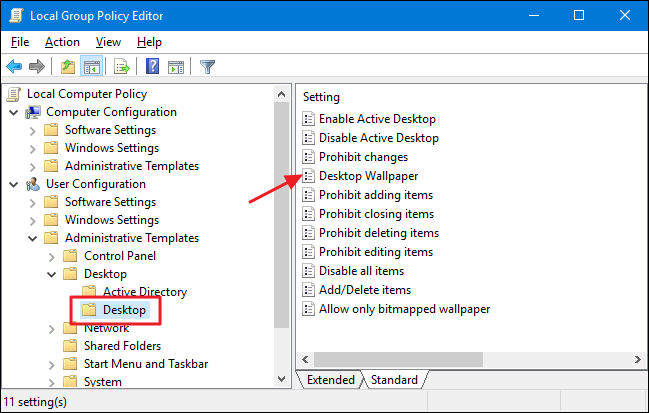
In the setting’s properties window, click the “Enabled” option. In the “Wallpaper Name” box, enter the full path to the JPG or BMP image you want to use as the desktop background. Set the “Wallpaper style” drop-down menu to how you want the image handled—centered, stretched, tiled, and so on. When you’re done, click “OK.”

When you’re done changing both settings, you can exit the Local Group Policy Editor. Changes take effect immediately, so no need to restart the PC or anything. To reverse the change later, just go back to the same “Prevent changing desktop background” and “Desktop Wallpaper” settings and change them back to “Not Configured.”


0 comments:
Post a Comment